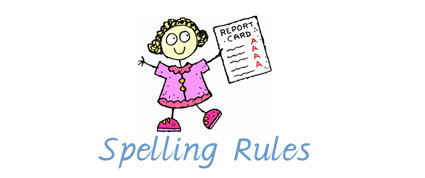
Below is a list of some of the most common spelling rules. Learning spelling these spelling rules will help you to become a better speller. Although there are exceptions to the rules, the majority of the words in the English language do follow these simple spelling rules.
This is a list of some of the most common spelling rules.
For a printable version click here
1. To make the long E sound at the ends of words use Y, EY, or IE. (E at the end of words is usually silent.)
2. C or K? At the beginning of a syllable use K before I and E. At the beginning of a syllable use C before A, O, or U.3. C, CK, K, or KE?
- Use CK at the end of a syllable with a SHORT vowel sound and no other consonants following the vowel. (examples: duck, pick)
- Use K at the end of a syllable with a short vowel sound and a consonant following the vowel. (examples: ask, bank)
- Use KE at the end of a syllable with a long vowel sound. (example: cake, bake) Use just K if there are two vowels working together to make the long vowel sound. (example: seek)
- C is sometimes used in words that have two syllables and end in IC. (examples music, panic, picnic, magic)
4. J, G, GE, or DGE?
- In the beginning of words, G or J can be used to spell the "J" sound before I, E, or Y. G is used more often.
- J must be used before A, O, or U in the beginning of words.
- Use GE or DGE to make the "J" sound at the ends of a syllable or word.
- Use DGE at the end of a syllable with a short vowel sound if the "J" sound immediately follows the vowel, (example: fudge, gadget, edge); otherwise use GE (example: sponge, age)
5. In one syllable words ending in L, F, and S, we often double them. (example: will, dress, puff)
6. Use VE at the ends of words. You never see a word end in V.
7. Use ED to make the "D", "T" or "ED" sound in verbs.
8. QU is a pair. Q is not found alone.
9. SH is used at the beginning of a word, or the end of a syllable. SH is NOT used at the beginning of a syllable after the first syllable.
10. SE or CE? Words ending in the "S" sound will often use SE or CE even with SHORT vowel sounds.
- CE is used for words with a long vowel words ending in the "S" sound.
- SE or CE can be used for short vowel words ending in the "S" sound.
11. Doubling consonants in the middle of words. Often you will see the consonant doubled in the middle of words with two syllables and short vowel sounds in both syllables. (example: little, pattern, gossip)
12. SION or TION or CIAN are used to spell the "shun" sound at the ends of words.
- Use SION when the root word ends in S or D.
- Use CIAN for root words that have to do with people. (example: musician, magician)
- Use TION for everything else.
13. Doubling final consonant.
- When a short vowel word with one syllable ends with one consonant, double the final consonant before adding the vowel suffix. (example: run, running). Do not double it if there is more than one consonant. (example: camp, camping)
- In a two syllable word, double the final consonant, if the accent is on the last syllable. (example: permitting)
14. Change the Y at the end of a word to I when adding a suffix except when adding ING. (example: funny, funnier)
15. Drop the silent E from a word when adding a vowel suffix.
16. If a word ends in GE or CE you must keep the silent E before adding a vowel suffix that ends in A, O, or U.
